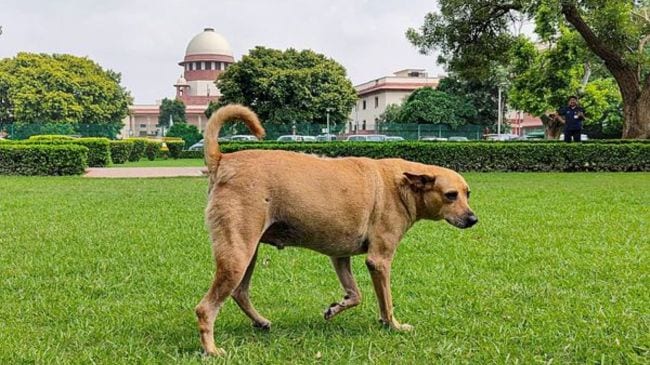Opinion For a country that believes in non-violence, SC order on stray dogs should be unacceptable
If everyday officials, ward officers, veterinary inspectors, panchayat staff, transport cops are trained to see animals as subjects whose suffering matters, then they are being trained, daily, to see weak lives as worthy of care. That is precisely the muscle we need to protect pavement dwellers, migrants, and forest-dependent communities
 Cruelty is rarely a single dramatic act. It is a series of administrative decisions that make suffering invisible and make removal sound reasonable.
Cruelty is rarely a single dramatic act. It is a series of administrative decisions that make suffering invisible and make removal sound reasonable. By Bharati Ramachandran
This year, we have seen a back-and-forth from the Supreme Court on street dogs: First staying an order to round up dogs, then directing that certain public spaces be cleared of them. Administrations immediately began adjusting to each swing. This casual pendulum — remove dogs/protect dogs/remove some dogs — tells you something deeper. We are getting comfortable with treating animals as dispensable.
History shows this is not a small moral slip. When I looked at plantation records from the 18th-19th century, what struck me wasn’t the violence, but the book-keeping: Oxen, horses, then human beings, all entered as “stock”. Those plantation owners didn’t wake up one morning and decide to brutalise people; they had already trained themselves to see sentient life in a narrow way — “Does it work for me or get in my way?” Once that lens is set for animals, moving certain humans into the same column is not a leap, it’s a slide.
That is the real warning in history. Cruelty is rarely a single dramatic act. It is a series of administrative decisions that make suffering invisible and make removal sound reasonable. You start with “clear this area”, “remove this nuisance”, “we don’t have capacity”. You start with “move the dogs” and the same tool is available for street vendors, informal settlements, even whole hamlets on valuable land. The mindset is identical: Life that causes friction can be moved, confined, or erased.
This is tragic, because, on paper, India remembers compassion. Our Constitution asks us to have compassion for all living creatures. The law, outdated as it is, still says unnecessary pain on animals is wrong. Our street-dog rules are humane by global standards: Sterilise, vaccinate, return — not kill. This means ahimsa is still somewhere in our civic imagination.
But listen to how we actually talk today about community dogs, “stray” cattle, animals in transport or dairies. Municipalities are under pressure, RWAs are angry, courts are told to “do something”, and the animal instantly becomes an administrative headache to be removed from the human eye. Shift them. Impound them. Send them to shelters (that don’t exist). Make them disappear.
All those clamouring for the removal of street dogs must remember: We imagine that human rights and animal protection live in separate boxes. They don’t. The state does not grow two different consciences, one for people and one for animals. It grows one habit of mind. If that habit of mind is that life at the margins is expendable, then all life on the margins will feel it. That’s the hidden danger when people say, “just shift the dogs”. We know that shifting without capacity means over-crowded, underfunded, spaces with slow suffering, and certain death. We know it violates the rules we made. And yet we suggest it, because it is administratively clean.
Ahimsa has to return, not as a slogan, but as a civic discipline. Ahimsa also means to refuse to do harm for speed, optics, or the convenience of the powerful. It is fully compatible with rabies control, public health, and safe cities; our Animal Birth Control rules prove this: They are a science-backed, humane approach. The opposite of ahimsa is not policing; it is the refusal to manage coexistence with “inconvenient” beings.
So what would it mean for India to maintain its core of ahimsa in 2025 and beyond?
It would mean reminding courts and municipalities that our national model for dogs is not removal but sterilisation–vaccination–return — and funding these efforts properly so they cannot plead helplessness. It would mean explicitly acknowledging that a state that practises compassion in small places is less likely to be brutal in big ones.
This is not about sentiment; it is about governance. If everyday officials, ward officers, veterinary inspectors, panchayat staff, transport cops are trained to see animals as subjects whose suffering matters, then they are being trained, daily, to see weak lives as worthy of care. That is precisely the muscle we need to protect pavement dwellers, migrants, and forest-dependent communities.
If we want to go on saying that India is a civilisation of non-violence, then our policies on the smallest, most inconvenient animals must look like it.
The writer is CEO, Federation of Indian Animal Protection Organisations (FIAPO)




